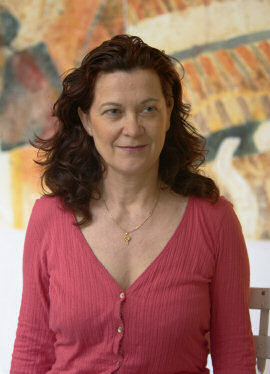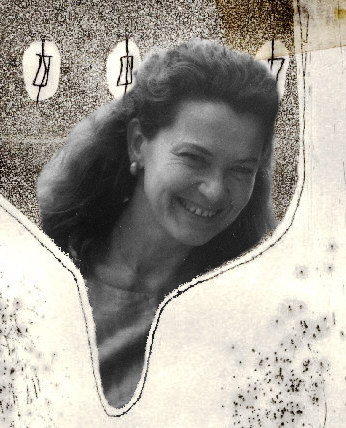The Copper-Engravings of Anne Mandorla,
When a paper loving painter like Anne Mandorla decides to take the path of the engraver's study, the collector of prints follows her first steps with interest, watches for the first tests. Where, how will the artist transpose the matter of her original creations, illuminate the printed copper, reproduce the force of the paper ruffled, torn, mackled with paint?
In our case, we can be astonished by the result, astonished in the first and primordial sense: with ease and boldness, the artist has quickly and skilfully applied the new put tools at her disposal. "C'est la peinture graphique de Klee, Dubuffet et Alechinsky qui m’a donné envie de graver. Ils creusent de sillons la pâte picturale en ôtant au lieu de charger. Leur geste aère la matière de lignes matricielles. C'est une autre façon d’aborder la peinture. Mais peinture et gravure sont très proches et le travail de l'une renvoie au travail de l’autre" . Through doubt and subtlety, the questioning of the copper's mirror turned the artist onto herself, helped her to find her usual themes transformed, metamorphosed, enriched.
Works of small size are born from the meeting of painting and engraving. The artist proceeds by small series of engravings which are, in fact, made up of original single prints pressed by a copper-plate engraving. Totems or fetishes, crosses or mandorles, flat discs gives their title to the series of 15, 20, even 30 copies.
This repertory of the usual forms in the mandorlien language is elaborate indifferently with acid, the drypoint, the graver or the black manner, on cut-out copper plates that, eventually, comes together like a puzzle. "J’ai abordé la technique de la gravure en 1995 J’avais imaginé que le burin allait être mon outil, mais j’ai rapidement déchanté devant la difficulté de le maîtriser ! Je l'utilise pour creuser un large sillon malhabile, très évident au centre de la plaque parmi les traits plus fins et grisés de la pointe-sèche et de l'eau-forte" .
The engraver develops the various expressions of this form by moving it in space around the vertical/horizontal axis. The print number 1 of the series is the print in black and white of this architectonic element. The following prints are impressions where this slipped form is combined with a paper applied, painted beforehand. The compositions of the engraved and painted elements are a combinative interpretation of the cross which returns regularly in the painted work.
"Manipulant avec force les couleurs dans la peinture, j’ai commencé à encrer mes premières plaques de cuivre de différentes couleurs ; mais les encres à graver se marient mal et leurs tonalités manquent de subtilité pour le résultat que je recherche. En conséquence, je me suis rapidement orientée vers le marouflage de petits papiers, préalablement peints, comportant souvent des empreintes de matrices en bois" .
The artist prints herself her production. She simultaneously passes under the press the inked plate and the maculated paper. "Lors du tirage, l’application en est très délicate ; j'utilise des outils de dentisterie pour la précision". The monumentality of the monolith is translated in printings which have for some the delicacy of the enluminure.
Anne Mandorla carries out the totality of the hard copy indicated, does not date it but titles it. The titles of these series are : Rêve excavé, Greniers de glaise, Mandorles, Plénitude - Déclin - Résurrection, Enclave territoriale, Exhumation de ruines, Esprit fétiche, Cueillette et chasse, Image rédemptrice, Corps seconds, Parure d'orant, Lignes fiducielles, Noyau cruciformel, Béhémot cryptuaire etc.
Like with her paintings, Anne Mandorla's engravings testifies the spiritual concerns, her search of the origins of thought as well as her interrogation of the fundamental myths. Born artist, she must express herself through matter; born painter, give sense and form through colour; born "mandorle", take inspiration from the symbolism of spirituality. For example, the series of the flat discs evokes cosmic Chinese jades of the Neolithic era.
In this engraved production, appears even more strongly still than in the large acrylic paintings, the paradox in the manner of the artist, mix of brute art and refinement, where precious papers are torn, vivified with golden gild, green watercolours which evoke the mirroring gleamings in Gustave Klimt, checkerworks delicately coloured like the sensitivity of Paul Klee's watercolours.
This attempt by Anne Mandorla to appropriate the know-how of the engraver, of the gestures several times centenaries offers an inventive production, resulting from a very personal approach. This art of engraving underlines the sophisticated contrast of delicacies of the blacks to the greys of the gravings with the stridency of the pigments related to the acrylic. The artist has known how to mix the delicacy of the support, always and still paper, the richness of the colour, the efficient elegance of her compositions to the refined primitiveness of her thematic.
These first successes encourage Anne Mandorla in the idea to develop and renew her research: "J’ai toujours envie d’expérimenter de nouvelles techniques, d’autant que je pressens d'inévitables interférences par la suite dans mon travail de peintre". It's guaranteed that these new experiments will offer us another testimony of her achievements as an artist.
- Marie Leroy–Crèvecœur, Paris, november l998

